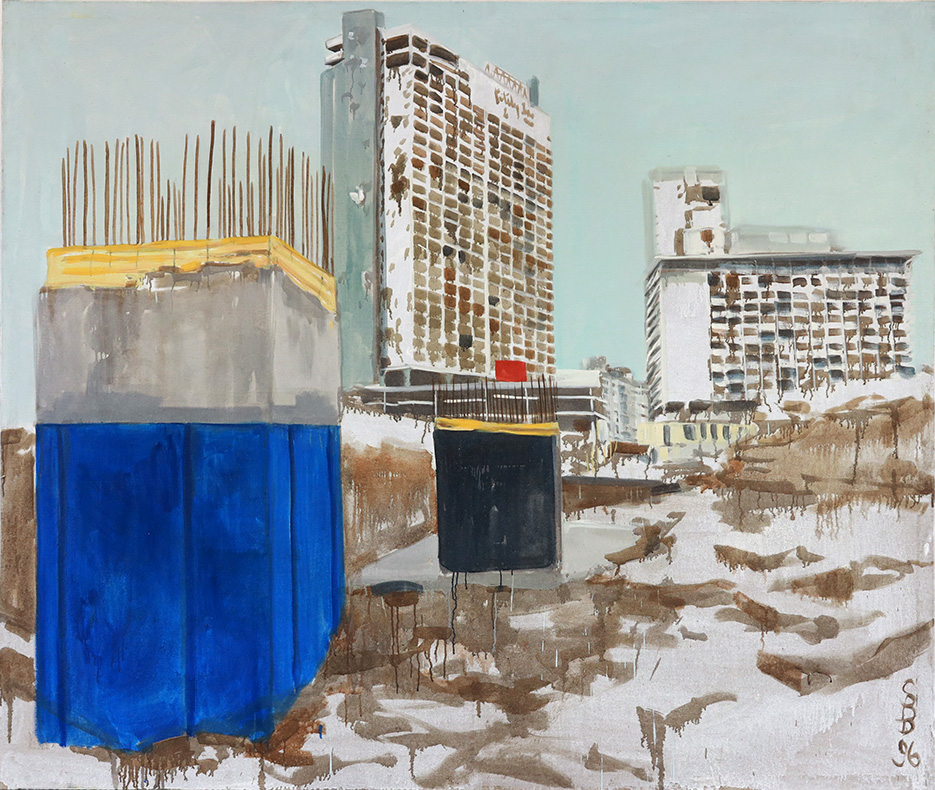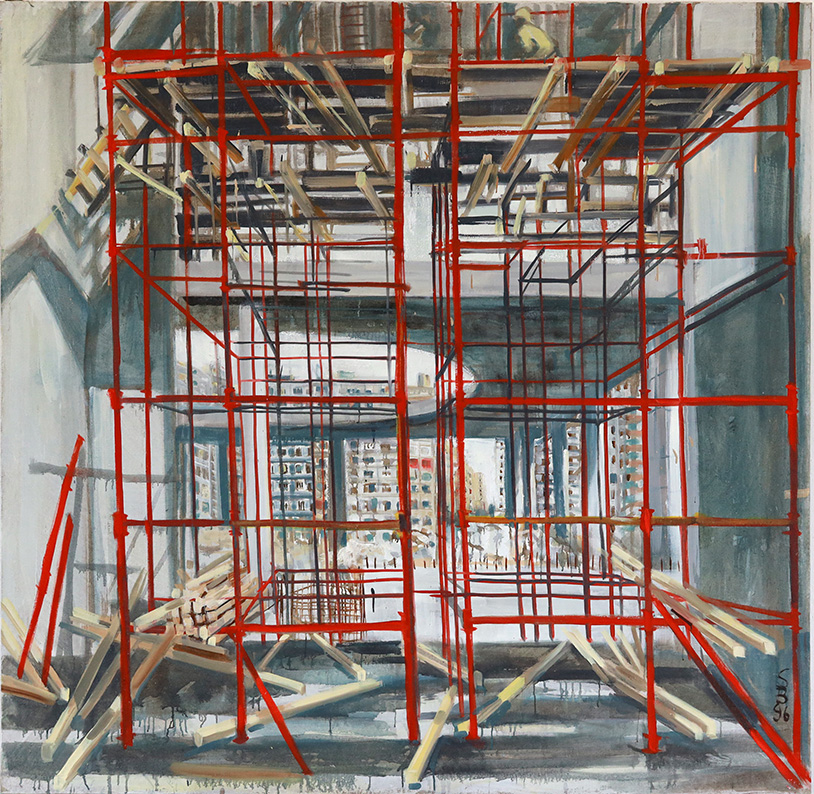Two separated cities in comparison

„Beirut – Berlin“ attempts to compare two capitals under reconstruction using the means of photography and painting, in texts and conversations. Beirut and Berlin have a lot in common. Due to war and division, both cities lack their historical center (Potsdamer Platz / Beirut’s old town), both habe been under reconstruction in 1990ies.The discourses, emotions and decisions in Beirut can be compared with those in Berlin at the time. The core of the artistic interest is the urban structure in the short period after division and before construction of a new center – of whatever kind – to fill the wastelands of history.
Not only the problems and the proposed urban planning solutions, but also the actual extent of the reconstruction plans in the centers were surprisingly similar. „Beirut – Berlin“ offers a view of interfaces and associative cross-connections and, with its interdisciplinary approach, points to connections between sociology, urban planning and art.
Beirut – Berlin 1993 – 1996



A Dialogue about Berlin – Beirut (1996)
„Beirut-Berlin“ attempts at artistically observing two capitals under reconstruction. What has motivated you in realizing a project which goes beyond the boundaries of just painting?
The motivation is born out of the process of painting itself. I consider this project as an element of my work, as builing sites have occupied a majority of themes in my painting for the past ten years. I was originally with the „Grands Projets“ in Paris in the eighties. At that time, my work was mainly dominated by the mark of construction techniques. The colourful scaffolding have captivated my attention to the same degree as did the piles of various building materials. On returning to Berlin I ceased to elaborate on specific technical details in a construction site, instead I began treating the whole of a construction site as a scenic, urban landcape. Unlike in Paris, in Berlin the whole of the heart of the city has been renovated, which leads to its opening after the fall of the Wall. Through my work the question rose at the time about the emptyness in a city center. On visiting Beirut I asked myself the same question: Here is a city which has been missing its center, just like Berlin.
The whole of Beirut Central District is currently in the process of being redefined and rebuilt. This is true of both, Berlin and Beirut. Moreover, both cities are a mirror image of diverse desires and hopes, mixed with the concept and difficult notion of a national identity.
The issues, emotions and decisions regarding the reconstruction of the center are easily comparable to those in Berlin. The core of my artistic interest was the attempt at an analysis of a short lapse of time between partition and reconstruction of a city center, no matter what it will look like in the future. In addition to this, both city centers have a further aspect in common: Public reactions and urban designs interact with the real dimension of the reconstruction plans.
Potsdamer Platz and Beirut Central District used to be the heartbeat of their respective towns. Both have been destroyed and divided by war. Both are full of emotional value. The comments, discussions and criticisms
surrounding the Master Plan of Potsdamer Platz are plentiful. But, going back to the issue of your personal motivation: It sounds like a presumption to make a comparison of reconstructing the city centers in both cities through art. Wouldn’t this rather be a subject for sociologists and urban designers?
It is quite an experience to be in a city which is not related to my own history, and yet, to find fragments which I can also relate to my own history. Every form of artistic interest is also a research of on€s own identity. When we discover traces of our own history, we will be in a position to understand a foreign city. When looking down from the highest floor of the Murr Tower, you realize what a sniper’s firingline means, you do so because you have already been in what used to be an observation tower by the former Berlin Wall. Therefore I find it possible to compare my current home, Berlin, with an unknown city like Beirut. In my paintings, the interlacing of different artistic visions go very far, as the images of both, Beirut and Berlin, in my work are not purely documentary; they become a conscious mixture of existing urban landscapes and imaginary elements.
The comparison further implies that Beirut and Berlin are two cities in a phase ofa post-war reconstruction. What the so called Cold War achieved, creating a divided city in Berlin, seventeen years of war in Berut did the same to the Lebanese capital. Reconstruction fever is most dominant in exactly these former borderlines, which have been the most important development areas after reunification in both cities.
Comparison usually entails the concentration of differences. Painting and photography provide suitable instruments for communicating this idea of the project, because they are sustainable without objectivity. Paradoxally this deliberately included subjectivity of the project is ideal for developing this theme, because it includes the possibility of deviations.
While the comparison between Beirut and Berlin does not claim to be complete in all facts and figures, it simply offers an overview. The project is neither a historic analysis, nor is it architecto-historic, but a poetic approach.
As an artist, I am in a position to have a insight into the city. I see the buildings and squares which suffered so much demolition, destruction and damage, and I see its people in the reality of their present. Often, people do not appear in the paintings, because I consider these gigantic building sites out of human scale. I hope that the recipient of this exhibition will be able to read this in the paintings. The technique and style of my paintings is rather classic and unspectacular. What regards my work, my decision to capture images of reconstruction in oil, a technique widely regarded as out-of-date, is a deliberate one as for me oil on canvas, more than any other media remains the suitable instrument of transmitting the different sides of a subject. Beirut is a broken town, even injured, but is in full revival. Unearthing and the cities new growth take place in the same time.
One can see the problematic, the contrasts and contradictions. We are not only comparing Beirut to Berlin, but also photography to painting. It does not compare the technical data of the engineering and reconstruction work.
Beirut and Berlin have developped in different ways over decades. They are barely comparable because of various architectural influences, and remain to be so on many grounds apart from the common fate of separation and destruction in their respective city centers. It is only today that the two cities are comparable. Division-demolitionreconstruction of the centers: It is in this context that our project is set up. What happened in Berlin after the World War I l , and after the fall of the Wall is happening today in Beirut.
Is the introduction of the „Anno Zero“ connotation of Germany’s past then afalacy in this comparison?
No. It is a consequence of it. An artistic inventory of the present has pinpointed the past. It is this that I hope my paintings will express. I wish to show the present state of working the ground and the unfinished. My aim is to capture these fugitive moments, through a traditional media such as oil painting, so that even now the city could be understood as movement and change.




Stefanie Bürkle – VG Bild-Kunst


